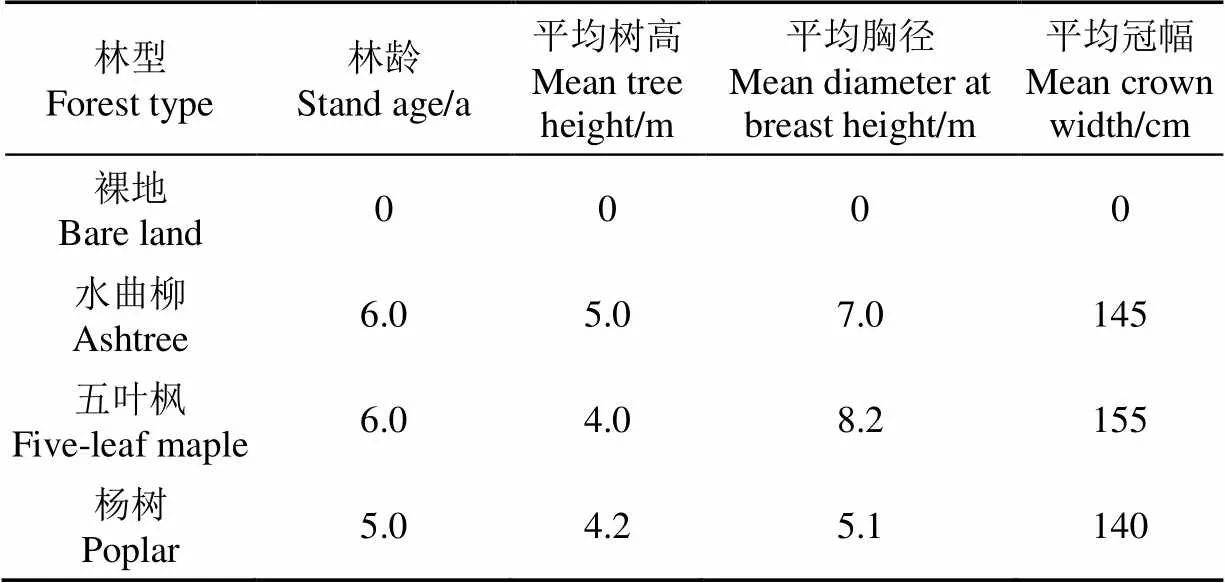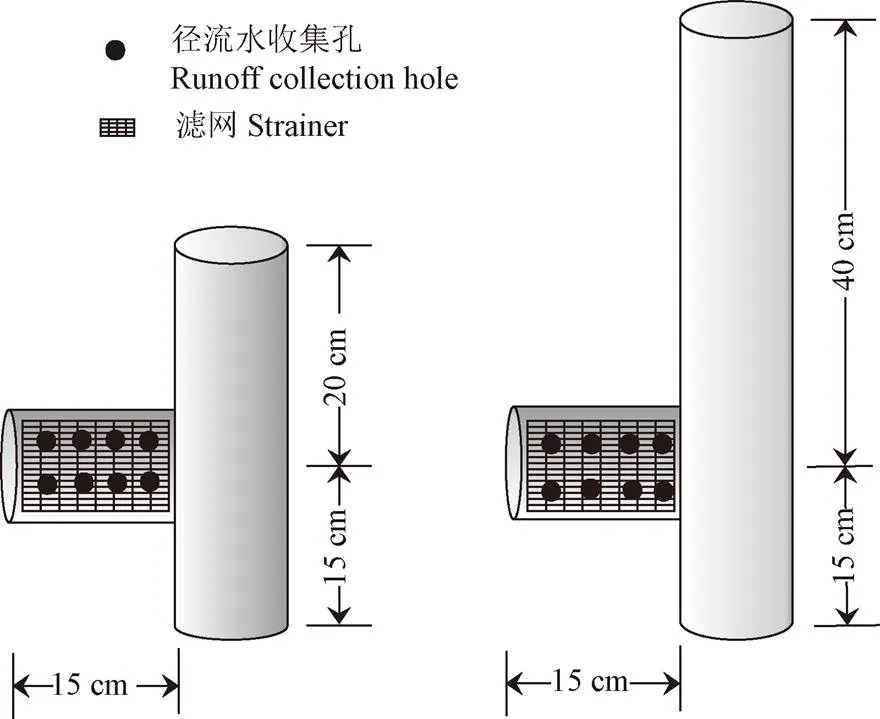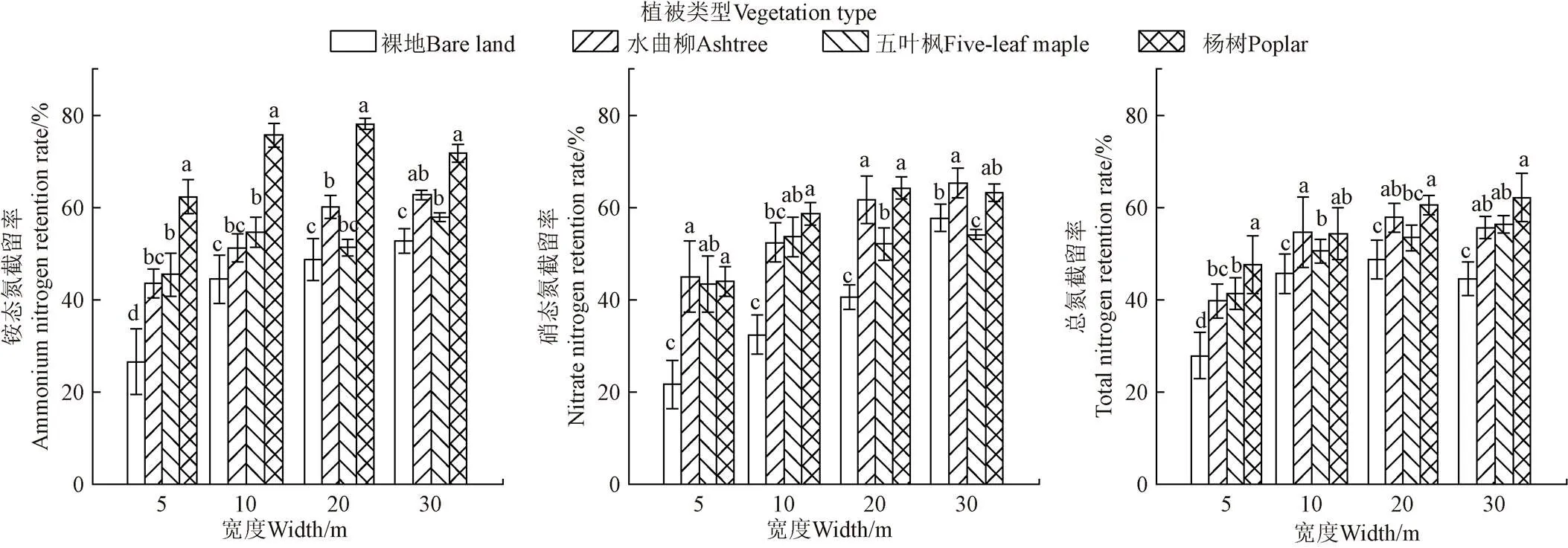河岸缓冲带植被布局对氮流失的影响
韩 旭,杜 崇,陈嘉硕,唐思玉
河岸缓冲带植被布局对氮流失的影响
韩 旭,杜 崇※,陈嘉硕,唐思玉
(黑龙江大学水利电力学院,哈尔滨 150006)
河岸缓冲带(Rriver Buffer Strips,RBSs)已被证明能有效拦截水流并去除氮,该研究旨在揭示不同配置缓冲带对脱氮效果的影响。实地布置河岸植被缓冲带,开展地下径流试验。缓冲带设置3种不同植物种类(水曲柳,五叶枫,杨树),和不同宽度(0、5、10、20、30 m),河岸坡度为3%,树木密度为540株/hm2。在此条件下,研究各类河岸植被缓冲带对地下径流铵态氮、硝态氮和总氮的截留效果。结果表明:20 m宽度河岸植被缓冲带能很好地截留各形态氮素。30 m宽度下,河岸植被缓冲带径流水中的铵态氮、硝态氮和总氮的截留率最高,分别为70.4%、67.7%和69.1%。在不同植物种类缓冲带比较中,杨树可显著降低径流铵态氮和总氮浓度,水曲柳可显著降低径流硝态氮浓度。在宽度与不同植物种类的交互关系中,20 m宽度杨树缓冲带对铵态氮和硝态氮的截留率最高,30 m宽度杨树缓冲带对总氮的截留率最高,为62.1%。研究结果可为东北地区中小型河流河岸缓冲设计最大化截留径流氮污染物提供参考。
氮;植被;坡度;河岸;缓冲带;截留率;宽度;地下径流深度
0 引 言
由化肥和农药的过量施用引起的农业非点源污染是全世界河流水质退化的主要原因之一[1]。河岸缓冲系统是用来控制农业非点源污染和保护河流环境的主要措施之一。河岸生态森林系统具有重要的生态意义,因为与非河岸生态森林系统相比,河岸森林具有更加丰富的植物,可以更加有效地保护河流水质和水生动物[2]。在各种非点源污染中,农田排放的氮污染物已成为当前水环境治理部门需要解决的一个基本难题。河岸植被缓冲带作为陆地生态系统与水生生态系统的连接,可有效地拦截农田地表径流的输入,并通过河岸缓冲带的物理截留作用或微生物转化作用有效地截留径流中的氮污染物[3-5]。河岸植被缓冲带宽度是决定河岸缓冲带氮素截留效率的一个重要因素。王芳等[6]发现河岸缓冲带的宽度决定了缓冲带是否能够充分发挥生态服务的功能。一般认为河岸缓冲带拦截氮的能力与宽度成正相关[7]。一个5 m宽的河岸缓冲带从地表径流中截留总氮和硝态氮的速率分别为40.2%和37.2%[8]。9.1 m和13 m宽的林草河岸缓冲带可分别截留78%和85%地表径流中的悬浮颗粒物[9]。中国巢湖流域23 m的草本和木本混合的河岸缓冲带对总氮的截留率达到50%[10]。有研究表明[11],12~15 m宽的河岸植被缓冲带是截留农田地表径流中氮素的最佳宽度。目前,许多研究就河岸缓冲带最佳宽度问题并未达成一致意见。在农田地表径流输入河岸缓冲带的过程中,河岸植被缓冲带主要通过渗透、过滤、吸收、滞留和沉积等[12]作用来有效地截留农田地表径流中的氮污染物,具体包括土壤和植物的吸附[13],反硝化和微生物固化等[14]。而最重要的截留机制之一就是植物拦截截留。河岸缓冲带的大型植物可以从地表径流中吸收氮污染物[15]。其中河岸缓冲带截留污染物的效果很大程度上取决于植物种类,因此如何确定河岸缓冲带的最佳植被类型尤为重要[16]。研究发现河岸落叶林缓冲区可以使地表径流中的氮含量降低68%[17]。然而,适当的植被配制对于有效减少污染物也很重要。
本文在松花江一级支流何家沟设计5种不同宽度、3种东北常见阔叶林树木类型的河岸植被缓冲带,在恒定的河岸坡度和植被密度下,研究农田径流中氮素截留情况,以获得使河岸带对氮素截留效果最佳的植被配置,以期为东北中小型河流选择最佳氮素截留的植被河岸缓冲带模式提供参考。
1 材料和方法
1.1 试验地概况
本试验在黑龙江省哈尔滨市西南部何家沟靠山屯段进行(126°15E′~126°34′E,45°42N′~45°44′N),研究地无霜期为168 d,年平均气温4.2 ℃,年均日照数为2 714.4 h,作物生长季积温为2 845.1 ℃。研究区内降水集中在夏秋两季,夏季为雨季,该地区平均降水天数为70.2 d,年平均降水量为524.7 mm。受河道保护政策影响以及随着河长制的全面推广,2015年春季在试验地先后人工种植了3种不同类型的树木,同时还留有1块裸地。3个地块的树木密度相同,为540株/hm2,试验地土壤为黑钙土,土壤糙度为1.14,在植树后立即测量4个地块40 cm深处土壤铵态氮、硝态氮和总氮的本底值,测量结果分别为1.15 mg/kg、2.84 mg/kg和2.68 g/kg。
1.2 试验布置
试验地点共有4块长15 m×宽30 m的人工林河岸地块,如图1所示。从左往右依次为裸地、水曲柳林、五叶枫林和杨树林,其基本特征见表1。4种河岸植被缓冲带地块各设置5个宽度(0、5、10、20、30 m),各个宽度与农田径流流入方向平行。淋溶水收集装置是利用内径为10 cm的聚氯乙烯三通管和60目(0.25 mm)滤网制成的试验淋溶管(图2),将聚氯乙烯三通管分别截成高35 cm和高55 cm,左侧淋溶水收集管道距离底部15 cm,左侧管出口和底部管出口用盖子封死,水孔的直径为4 mm,且水孔用滤网包裹紧密,淋溶管在铺设河岸种植树木的过程中进行埋设,在每个地块不同宽度处分别交叉埋设2组聚氯乙烯淋溶管,每组2个,每组淋滤管的深度分别为20和40 cm,用于地下径流水样的采集。每个淋滤管之间的距离为3 m,且各组之间用PVC挡水板隔开,挡水板插入深度为50 cm(图3)。利用施肥机在每个地块前0~0.5 m处均匀施肥,依据当地农田施肥量61 kg/hm2,所施氮磷钾复合肥比率为24∶6∶35,在降雨前施肥,降雨产流后采样,施肥与采样间隔8 d。试验样品在当地雨季6 —9月采集,3次采样时间分别为2021年6月23日—6月25日,2021年8月6日—8月7日,2021年9月19日—21日。采样前8天平均降水量分别为63.1、85.3和76.5 mm。

图1 试验地示意图
1.3 样本采集和测定方法
1.3.1 径流收集方法
使用小型抽水器抽取淋滤管中的径流水清液,并将其装入300 mL的塑料瓶中,将样本带回实验室存储在-4~0 ℃的冰箱内,快速测定水样中不同形态的氮,在每次取样后,将淋滤管中的水排干,并在远离采样区的地方排空。

表1 林型基本特征

图2 PVC淋溶管

图3 各地块试验布置图
1.3.2 水样中氮素分析方法
水样先经过0.45m滤膜抽滤预处理,然后,利用纳氏试剂分光光度法[18]测量水样铵态氮(NH4+-N),利用紫外分光光度法[19]测量水样硝态氮(NO3--N),利用碱性过硫酸钾消解紫外分光光度法[20]测量水样总氮(Total N,TN)。759MC型号紫外分光光度计生产厂家为上海高致精密公司,精度±5 nm,EFD-NH型精密铵态氮测定仪生产厂家合肥恩帆仪器设备公司,精度≤±5%。
氮截留率采用式(1)计算:
R=(0-C)/0×100% (1)
式中是河岸植被缓冲带宽度,m;R是宽度下的氮累积截留率,%;C是宽度下的氮浓度,mg/L;0是宽度为0处径流水的氮浓度,mg/L。
1.4 统计分析
取3次数据采样平均值进行分析。 Origin2018对数据进行统计绘图,利用SPSS23.0版软件对数据进行统计分析,采用单因素方差分析(One way ANOVA)并利用最小二乘(Least Significant Difference,LSD)、邓肯(Duncan’s Multiple Range Test)多重比较方法对平均值进行差异显著性检验,差异在小于0.05时具有统计意义。
2 结果与分析
2.1 植被类型对土壤理化性质的影响
2015年开始试验布置,2021年采样测定各小区土壤理化性质如表2。由表可知,种植6 a不同植被后,4个缓冲带地块40cm深土壤的pH差异不显著(0.05)。水曲柳、五叶枫和杨树缓冲带土壤的容重小于裸地土壤的容重(0.05)。水曲柳、五叶枫和杨树缓冲带土壤的总孔隙度和土壤贮水量大于裸地土壤的总孔隙度和土壤贮水量(0.05)。在裸地缓冲带中,土壤的铵态氮和硝态氮质量分别为5.47和7.86 mg/kg,总氮的质量为4.73 g/kg,高于铵态氮、硝态氮和总氮的本底值,这可能是因为6 a中在施有过量氮肥的农田在多次降雨形成下形成农田径流,含有氮素的农田地表径流在流经裸地缓冲带后,使得裸地缓冲带土壤中氮素质量升高。由于植被类型的不同,植被在吸收氮素方面存在差异。水曲柳、五叶枫和杨树河岸缓冲带土壤中铵态氮、硝态氮和总氮质量与裸地缓冲带差异显著(<0.05),这说明在裸地上种植植被可有效降低氮素含量。而杨树河岸缓冲带铵态氮含量显著低于水曲柳和五叶枫河岸缓冲带(<0.05),这可能是由于杨树的林龄相较于水曲柳和五叶枫的林龄要小,需要更多铵态氮含量来维持自身生长造成的。

表2 2021年土壤理化性质
注:同行不同小写字母表示各林型间氮素差异显著(<0.05)。
Note: Different lowercase letters in the same row indicate significant differences among forest types (<0.05).
2.2 植被类型、土壤深度与缓冲带宽度对径流氮的交互影响
对植被类型、土壤深度和缓冲带宽度因素进行方差分析,结果见表3。植被类型、缓冲带宽度对铵态氮、硝态氮和总氮影响显著;而各因素交互影响不显著。又从表中看出,地下径流深度与河岸缓冲带宽度和植被类型无显著交互影响,因而接下来的分析中将20和40 cm土壤深度的氮素值进行平均处理,重点分析不同宽度、不同植被类型和不同宽度×不同植被类型对氮素截留影响。

表3 不同因素对径流氮影响的方差分析P值结果
注:<0.05,显著。
Note: Significance (< 0.05).
2.3 不同宽度河岸缓冲带对氮素截留的差异
2.3.1 不同宽度河岸带对NH4+-N截留的影响
如图4所示,铵态氮浓度随着河岸植被缓冲带宽度的增加而降低。宽度0、5、10 、20 m河岸植被缓冲带径流铵态氮浓度分别为0.681、0.375、0.270和0.214 mg/L,差异显著(<0.05);宽度30 m河岸植被缓冲带的径流铵态氮截留率为70.4%,与20 m河岸植被缓冲带截留率无显著差异(>0.05),二者显著高于5和10 m宽河岸植被缓冲带铵态氮截留效率(<0.05)。5、10和20 m宽度河岸植被缓冲带铵态氮截留率分别为48.9%、63.3%和69.6%,差异显著(<0.05),而在20~30 m宽度河岸缓冲带中,对铵态氮截留率相较于5~20 m来说截留效率放缓。


a. 铵态氮浓度a. Ammonium nitrogen concentrationb. 铵态氮截留率b. Ammonium nitrogen retention rate
注:不同字母代表差异显著(<0.05)。下同。
Note: Different letters represent significant differences (< 0.05). Same as below.
图4 不同缓冲带宽度对径流中铵态氮的影响
Fig.4 Effects of different buffer zone widths on ammonium nitrogen in runoff
2.3.2 不同宽度河岸带对NO3--N截留的影响
由图5所示,宽度0、5、10和20 m的径流硝态氮浓度分别为0.792、0.546、0.371和0.290 mg/L,差异显著(<0.05),宽度5、10、20和30 m河岸植被缓冲带的硝态氮截留率分别为34.7%、53.7%、64.2%和67.7%,30 m与20 m河岸植被缓冲带硝态氮截留率无显著差异(>0.05),但显著高于5 和10 m宽河岸植被缓冲带硝态氮截留效率(<0.05)。随着宽度的增加,硝态氮的浓度降低,截留率上升[21-22],宽度30 m的河岸植被缓冲带具有最高的地下径流硝态氮截留率,这样的结果与铵态氮类似。

a. 硝态氮浓度a. Nitrate nitrogen concentrationb. 硝态氮截留率b. Nitrate nitrogen retention rate
2.3.3 不同宽度河岸带对总氮(TN)截留的影响
如图6所示,在径流水中,总氮浓度随着河岸植被缓冲带宽的增加而降低,这说明土壤在农田径流水下渗的过程中截留吸附了径流中的部分氮污染物,这与黄玲玲[23]研究中的土壤的吸附作用使得径流中氮浓度降低相一致。宽度0、5、10、20和30 m缓冲带径流总氮浓度分别为4.137、2.581、2.343、1.486和1.371 mg/L,其中宽度20和30 m缓冲带径流总氮浓度与宽度0、5和10 m缓冲带径流总氮浓度差异显著(<0.05)。宽度5、10、20 和30 m缓冲带径流总氮截留率分别为39.8%、42.1%、64.7%和69.1%,并且20和30 m缓冲带径流总氮截留率与10和20 m缓冲带径流截留率差异显著(<0.05)。

a. 总氮浓度a. Total nitrogen concentrationb. 总氮截留率b. Total nitrogen retention rate
结合河岸植被缓冲带3种氮素分析表明:径流中铵态氮,硝态氮和总氮的浓度随着河岸植被缓冲带宽度的增加而逐渐减少,这与朱晓成等[24-25]研究的结果基本一致,这可能是当河岸缓冲带的宽度逐渐增大时,使得径流氮污染物与植被缓冲带的作用时间边长,促进了地表径流下渗,进而促进土壤和植物对氮素的截留和吸收。在氮素的截留率方面,20和30 m宽的河岸植被缓冲带的铵态氮,硝态氮和总氮的截留率差异不显著(>0.05),可见,宽度20 m的河岸植被缓冲带就能够对3种氮素进行很好截留。
2.4 不同植被类型对河岸缓冲带氮素截留的差异
如图7所示,以裸地缓冲带地块为对照,来分析水曲柳、五叶枫和杨树植被缓冲带地块在铵态氮、硝态氮和总氮截留差异。裸地、水曲柳、五叶枫和杨树缓冲带的铵态氮浓度分别为0.428、0.372、0.364和0.269 mg/L。水曲柳、五叶枫和杨树缓冲带的铵态氮浓度与裸地植被缓冲带差异显著(<0.05),其中杨树缓冲带的铵态氮浓度显著低于水曲柳和五叶枫缓冲带(<0.05),这可能是因为相对于水曲柳与五叶枫来说,杨树的树龄更小,维持自身生长所需吸收的铵态氮更多造成的。
由图7b可知,裸地、水曲柳、五叶枫和杨树缓冲带的硝态氮浓度分别为0.476、0.322、0.414和0.392 mg/L。各植被缓冲带硝态氮浓度与裸地缓冲带硝态氮浓度差异显著(<0.05),而水曲柳缓冲带硝态氮浓度显著低于五叶枫和杨树缓冲带(<0.05),这说明相对于五叶枫和杨树缓冲带,水曲柳缓冲带具有吸收更多硝态氮的特性。
由图7c可知,裸地、水曲柳、五叶枫和杨树缓冲带的总氮浓度分别为2.588、1.352、1.896和1.117 mg/L,水曲柳和杨树缓冲带总氮浓度显著低于五叶枫河岸缓冲带(<0.05),且水曲柳与杨树缓冲带总氮浓度差异不显著(>0.05),这说明水曲柳与杨树缓冲带相比于五叶枫缓冲带具有降低径流总氮浓度的特性。
结合上述分析可知,水曲柳、五叶枫和杨树河岸植被缓冲带可有效降低径流氮素浓度,杨树缓冲带在降低径流铵态氮浓度方面效果最好,水曲柳缓冲带在降低硝态氮浓度方面效果最好,水曲柳与杨树缓冲带相较于五叶枫缓冲带在降低径流总氮浓度方面效果更好,且水曲柳与杨树缓冲带在降低径流总氮浓度方面效果类似。
2.5 缓冲带宽度和植被类型对河岸缓冲带氮素截留的差异
图8显示了植被类型(水曲柳,五叶枫,杨树)的河岸缓冲带对地下径流中铵态氮的截留效果。当径流经过河岸缓冲区后,径流中铵态氮浓度显著降低,在不同植被类型的河岸缓冲带对铵态氮截留率存在明显差异。在宽度5、10和20 m河岸植被缓冲带下,杨树河岸缓冲带的铵态氮截留率分别为62.3%、75.7%和78.1%,与水曲柳、五叶枫和裸地河岸缓冲带的铵态氮截留率差异显著(<0.05)。而在30 m宽度的河岸植被缓冲带下,杨树与水曲柳河岸缓冲带的铵态氮截留率差异不显著(>0.05)。在各宽度河岸植被缓冲带中,杨树河岸缓冲带是铵态氮截留效率最高的缓冲带,这主要由于试验样地的杨树处于幼年期,相较于五叶枫林和水曲柳林来说,幼年杨树林需要吸收更多养分,可能对径流水中的铵态氮有较高的截留率。20 m宽度的杨树河岸缓冲带铵态氮截留率最大为78.1%,比水曲柳,五叶枫和裸地河岸缓冲带截留率分别高17.9%,26.8%和29.4%。


a. 铵态氮浓度a. Ammonium nitrogen concentrationb. 硝态氮浓度b. Nitrate nitrogen concentrationc. 总氮浓度c. Total nitrogen concentration
注:BL为裸地、AT为水曲柳、FLM为五叶枫、PL为杨树。
Note: BL is bare land, AT is ashtree, FLM is five-leaf maple, PL is poplar.
图7 不同缓冲带植被类型对径流中氮素浓度的影响
Fig.7 Effect of different buffer zone vegetation types on nitrogen concentration in runoff

a. 铵态氮a. Ammonium nitrogenb. 硝态氮b. Nitrate nitrogenc. 总氮c. Total nitrogen
不同植被类型的河岸缓冲带对径流中硝态氮的截留效果如图8b所示,在宽度5和30 m的河岸缓冲带中,水曲柳河岸缓冲带对径流硝态氮的截留率最高,分别为45%和65.3%,宽度10和20 m的杨树河岸缓冲带对径流硝态氮的截留率分别为58.6%和64.2%,宽度20 m的五叶枫河岸缓冲带的径流硝态氮截留率为52.1%,相较于宽度10 m的五叶枫河岸缓冲带的硝态氮截留率53.6%略有下降。杨树河岸缓冲带在20 m宽度时,径流硝态氮截留率最大,为64.2%,与五叶枫和裸地河岸缓冲带截留率差异显著(<0.05),但与水曲柳差异不显著(>0.05),其中杨树河岸缓冲带比水曲柳、五叶枫和裸地河岸缓冲带硝态氮截留率分别高2.1%、12.1%和23.6%,截留率从高到低依次为杨树林、水曲柳林、五叶枫林、裸地。30 m宽度下,水曲柳河岸缓冲带与五叶枫河岸缓冲带径流硝态氮截留率分别为65.3%和54.1%,差异显著(<0.05),而在其他宽度下,二者径流硝态氮平均截留率并没有显著差异(>0.05)。在5和10 m宽的河岸缓冲带上,水曲柳缓冲带与五叶枫缓冲带的径流硝态氮平均截留率差异不显著(>0.05)。
对于总氮来说,如图8c所示,在宽度5 m河岸植被缓冲带下,水曲柳、五叶枫和杨树河岸缓冲带的总氮截留率分别为39.7%、41.2%和47.6%,与裸地河岸缓冲带差异显著(<0.05)。在宽度5、20和30 m河岸植被缓冲带中,杨树河岸缓冲带有着最高的径流总氮截留率,分别为47.6%、60.5%和62.1%。在宽度10 m河岸植被缓冲带下,杨树河岸缓冲带与水曲柳河岸缓冲带的径流总氮截留率相近,分别为54.6%和54.3%,并且差异不显著(>0.05)。在30 m处,水曲柳、五叶枫和杨树河岸缓冲带的总氮截留率与裸地河岸缓冲带总氮截留率存在显著差异(<0.05)。在宽度10和20 m的河岸植被缓冲带中,水曲柳林径流总氮截留率与五叶枫林差异不显著(>0.05)。
王金亮等[26]研究表明,在较缓坡度上,林地坡地相比于旱坡地来说,林地坡地阻力较大。所以,在一定坡度下,河岸缓冲带的植被通过输送和吸收溶解氧为微生物提供栖息地,降低径流流速,疏松土壤等机制来预防和控制非点源污染[27-28]。这种机制在每个反应中可能会因河岸植被缓冲带的条件不同而有所不同,某种机制可能对某种的氮污染物非常有效[29]。不同类型的植被造成植物组织组成,根系类型和活动强度的差异,导致不同植被类型的河岸缓冲带对氮污染物的吸收和转化存在差异[30]。本研究中,3种河岸植被缓冲带对铵态氮,硝态氮和总氮的截留能力均高于裸地,这表明不同植被类型的缓冲带对径流水中氮污染物有着很好的截留效果。杨树林河岸缓冲带对径流水中铵态氮和总氮的平均截留率较高,除宽度30 m外,在其他宽度下,杨树林河岸缓冲带铵态氮的平均截留率与水曲柳林和五叶枫林河岸缓冲带铵态氮平均截留率差异显著(<0.05),对于总氮来说,各宽度下杨树林总氮平均截留率与水曲柳林总氮平均截留率差异不显著(>0.05)。各宽度杨树林缓冲带对径流水中硝态氮平均截留率的总和略高于各宽度水曲柳林缓冲带对径流水中硝态氮平均截留率的总和,这可能是因为杨树的根系比水曲柳的更深,能够吸收更多淋溶到深层土壤中的硝态氮,且试验点的树种处于幼年期,对养分的需求量大。
3 结 论
布置3种不同植物种类(水曲柳,五叶枫,杨树)和不同河岸植被缓冲带宽度(5、10、20、30 m),开展地下径流试验,研究各类河岸植被缓冲带对地下径流铵态氮、硝态氮和总氮的截留效果,结果表明:有植被覆盖的河岸缓冲带截留氮素效果显著高于无植被覆盖的河岸缓冲带(裸地),宽度20 m的河岸缓冲带对由模拟农田输入径流氮的污染物的截留效果显著,满足脱氮的预期目标。在3种不同河岸植被缓冲带中,杨树林对铵态氮的截留率最高,且与五叶枫林,水曲柳林截留差异显著(<0.05)。对于硝态氮来说,宽度10和20 m的杨树河岸缓冲带对径流硝态氮的平均截留效率与五叶枫林于水曲柳林的径流硝态氮的平均截留效率差异显著(<0.05),但在宽度5和30 m下,径流硝态氮的平均截留效率差异不显著(>0.05)。在总氮的情况下,除宽度10 m杨树河岸缓冲带径流总氮的截留率略低于水曲柳河岸缓冲带径流总氮的截留率,其他宽度下,杨树河岸缓冲带径流总氮的截留率均最高。综合以上结果,结合东北地区生态经济条件来说,20 m宽度杨树林河岸缓冲带对于氮污染物的截留达到最大化的效果。
[1] Hénault-Ethier L, Gómes Marcelo Pedrosa, Lucotte M, et al. High yields of riparian buffer strips planted with Salix miyabena 'SX64' along field crops in Québec, Canada[J]. Biomass & Bioenergy, 2017, 10(5): 219-229.
[2] Luke S H, Slade E M, Gray C L, et al. Riparian buffers in tropical agriculture: Scientific support, effectiveness and directions for policy[J]. Journal of Applied Ecology, 2019, 56(1): 85-92.
[3] 刘瑞霞,王立阳,孙菲,等. 以农业面源污染阻控为目标的河流生态缓冲带研究进展[J]. 环境工程学报,2022,16(1):25-39.
Liu Ruixia, Wang Liyang, Sun Fei, et al. Research progress in riverine ecological buffer zone for control of agricultural non-point source pollution[J]. Chinese Journal of Environmental Engineering, 2022, 16(1): 25-39. (in Chinese with English abstract)
[4] 刘赢男,杨帆,韩辉,等. 阿什河流域河岸植被缓冲带宽度规划[J]. 国土与自然资源研究,2018(6):46-48.
Liu Yingnan, Yang Fan, Han Hui, et al. Width planning of riparian vegetation buffer zone in Ashe River Basin[J]. Land and Natural Resources Research, 2018(6): 46-48. (in Chinese with English abstract)
[5] Dlamini J C, Cárdenas L, Tesfamariam E H, et al. Soil methane (CH4) fluxes in cropland with permanent pasture and riparian buffer strips with different vegetation[J]. Journal of Plant Nutrition and Soil Science, 2021, 185(1): 132-144.
[6] 王芳,汪耀龙,谢祥财. 生态学价值视角下的城市河流绿道宽度研究进展[J]. 中国城市业,2019,17(1):57-61.
Wang Fang, Wang Yaolong, Xie Xiangcai. Research progress of urban river greenway width from the perspective of ecological value[J]. China Urban Industry, 2019, 17(1): 57-61. (in Chinese with English abstract)
[7] Lyu C J, Li X J, Yuan P, et al. Nitrogen retention effect of riparian zones in agricultural areas: A meta-analysis[J]. Journal of CleanerProduction, 2021, 315: 128143.
[8] 张鸿龄,李天娇,赵志芳,等. 辽河河岸植被缓冲带构建及其对固体颗粒物和氮阻控能力[J]. 生态学杂志,2020,39(7):2185-2192.
Zhang Hongling, Li Tianjiao, Zhao Zhifang, et al. Construction of vegetation buffer zone along the Liaohe river bank and its resistance and control ability to solid particulate matter and nitrogen[J]. Chinese Journal of Ecology, 2020, 39(7): 2185-2192. (in Chinese with English abstract)
[9] 汤家喜,何苗苗,王道涵,等. 河岸缓冲带对地表径流及悬浮颗粒物的阻控效应[J]. 环境工程学报,2016, 10(5):2747-2755.
Tang Jiaxi, He Miaomiao, Wang Daohan, et al. Effect of riparian buffer zone on surface runoff and suspended particulate matter[J]. Chinese Journal of Environmental Engineering, 2016, 10(5): 2747-2755. (in Chinese with English abstract)
[10] Cao X, Song C, Xiao J, et al. The optimal width and mechanism of riparian buffers for storm water nutrient rem oval in the Chinese Eutrophic Lake Chaohu Watershed[J]. Water, 2018, 10(10): 1-11.
[11] Kiffney P M, Bull R J P. Responses of periphyton and insects to experim ental manipulation of riparian buffer width along forest streams[J]. Journal of Applied Ecology, 2010, 40(6): 1060-1076.
[12] Li Y, Chen Z, Lou H, et al. Denitrification controls in urban riparian soils: Implications for reducing urban nonpoint source nitrogen pollution[J]. Environmental Science & Pollution Research, 2014, 21(17): 10174-10185.
[13] 胡海波,邓文斌,王霞. 长江流域河岸植被缓冲带生态功能及构建技术研究进展[J]. 浙江农林大学学报,2022,39(1):214-222.
Hu Haibo, Deng Wenbin, Wang Xia. Research progress on ecological function and construction technology of riparian vegetation buffer zone in the Yangtze River Basin[J]. Journal of Zhejiang A & F University, 2022, 39(1): 214-222. (in Chinese with English abstract)
[14] 孙金伟,许文盛. 河岸植被缓冲带生态功能及其过滤机理的研究进展[J]. 长江科学院院报,2017,34(3):40-44.
Sun Jinwei, Xu Wensheng. Research progress on ecological function and filtration mechanism of riparian vegetation buffer zone[J]. Journal of Yangtze River Scientific Research Institute, 2017, 34(3): 40-44. (in Chinese with English abstract)
[15] Johnson R K, Burdon F J, et al. Forested riparian buffers change the taxonomic and functional composition of stream invertebrate communities in agricultural catchments[J]. Water, 2021, 13(8): 1-17.
[16] 纪钦阳. 九龙江北溪河岸植被缓冲带构建实验区氮、磷削减研究[D]. 福州:福建师范大学,2016.
Ji Qinyang. Research on Nitrogen and Phosphorus Reduction in the Experimental Area of Constructing the Vegetation Buffer Zone on the North River Bank of Jiulong River[D]. Fuzhou: Fujian Normal University, 2016. (in Chinese with English abstract)
[17] Li R, Kuo Y M. Effects of shallow water table depth on vegetative filter strips retarding transport of nonpoint source pollution in controlled flume experiments[J]. 2021, 15(1): 163-175.
[18] 张臻宇. 连续流动分析法和纳氏试剂分光光度法测定地表水氨氮的比较研究[J]. 环境与发展,2020,32(11):87-88.
Zhang Zhenyu. Comparative study on determination of ammonia nitrogen in surface water by continuous flow analysis and Nessler's reagent spectrophotometry[J]. Environment and Development, 2020, 32(11): 87-88. (in Chinese with English abstract)
[19] 李欣然,何岩,朱瑾,等. 丙烯基硫脲和钼酸钠对紫外分光光度法和酚二磺酸光度法测定硝态氮的影响[J]. 化学世界,2019,60(3):149-155.
Li Xinran, He Yan, Zhu Jin, et al. Effect of propylene thiourea and sodium molybdate on the determination of nitrate nitrogen by ultraviolet spectrophotometry and phenol disulfonic acid spectrophotometry[J]. Chemical World, 2019, 60(3): 149-155. (in Chinese with English abstract)
[20] 谷东杰,刘倩. 碱性过硫酸钾消解紫外分光光度法测定水中总氮[J]. 山东化工,2020,49(11):103-105.
Gu Dongjie, Liu Qian. Determination of total nitrogen in water by ultraviolet spectrophotometry with alkaline potassium persulfate digestion[J]. Shandong Chemical Industry, 2020, 49(11): 103-105. (in Chinese with English abstract)
[21] 王晓琪,姚媛媛,陈宝成,等. 淹水条件硝态氮和铵态氮配施对水稻生长与土壤养分的影响[J]. 土壤,2020,52(2):254-261.
Wang Xiaoqi, Yao Yuanyuan, Chen Baocheng, et al. Effects of combined application of nitrate and ammonium nitrogen on rice growth and soil nutrients under flooding conditions[J]. Soils, 2020, 52(2): 254-261. (in Chinese with English abstract)
[22] 李怀恩,邓娜,杨寅群,等. 植被过滤带对地表径流中污染物的净化效果[J]. 农业工程学报,2010,26(7):81-86.
Li Huaien, Deng Na, Yang Yinqun, et al. Clarification efficiency of vegetative filter strips to several pollutants in surface runoff[J]. Transactions of the Chinese Society of Agricultural Engineering (Transactions of the CSAE), 2010, 26(7): 81-86. (in Chinese with English abstract)
[23] 黄玲玲. 竹林河岸带对氮磷截留转化作用的研究[D]. 北京:中国林业科学研究院,2009.
Huang Lingling. Study on the Interception An Transformation of Nitrogen and Phosphorus in the Riparian Zone of Bamboo Forest[D]. Beijing: Chinese Academy of Forestry Sciences, 2009. (in Chinese with English abstract)
[24] 朱晓成,吴永波,余昱莹,等. 太湖乔木林河岸植被缓冲带截留氮素效率[J]. 浙江农林大学学报,2019,36(3):565-572.
Zhu Xiaocheng, Wu Yongbo, Yu Yuying, et al. Nitrogen interception efficiency of riparian vegetation buffer zone of arbor forest in Taihu Lake[J]. Journal of Zhejiang A & F University, 2019, 36(3): 565-572. (in Chinese with English abstract)
[25] Lv J, Wu Y. Nitrogen removal by different riparian vegetation buffer strips with different stand densities and widths[J]. Water Science & Technology Water Supply, 2021, 11: 1-16.
[26] 王金亮,陈成龙,倪九派,等. 小流域农业面源污染阻力评价及“源-汇”风险空间格局[J]. 农业工程学报,2018,34(10):216-224.
Wang Jinliang, Chen Chenglong, Ni Jiupai, et al. Resistance evaluation and “source-sink” risk spatial pattern of agricultural non-point source pollution in small catchment[J]. Transactions of the Chinese Society of Agricultural Engineering (Transactions of the CSAE), 2018, 34(10): 216-224. (in Chinese with English abstract)
[27] 杨世琦,邢磊,刘宏元,等. 植物篱埂垄向区田技术对坡耕地水土和氮磷流失控制研究[J]. 农业工程学报,2019,35(22):209-215.
Yang Shiqi, Xing Lei, Liu Hongyuan, et al. Effect of reducing runoff, sediment, soil nitrogen and phosphorus losses in sloping farmland based on short ridge of clover hedgerow with ridge tillage[J]. Transactions of the Chinese Society of Agricultural Engineering (Transactions of the CSAE), 2019, 35(22): 209-215. (in Chinese with English abstract)
[28] 刘燕,夏品华,郑钧宁,等. 河岸缓冲带植物配置模式对面源污染物的净化效果[J]. 贵州农业科学,2014(10):248-251.
Liu Yan, Xia Pinhua, Zheng Junning, et al. Purification effect of surface source pollutants by plant configuration mode in riparian buffer zone[J]. Guizhou Agricultural Science, 2014(10): 248-251. (in Chinese with English abstract)
[29] 孙东耀. 不同植被河岸缓冲带系统对氮磷污染物的拦截过程研究[D]. 福建:福建师范大学,2018.
Sun Dongyao. Study on Interception Process of Nitrogen and Phosphorus Pollutants by Different Vegetation Riparian Buffer Zone Systems[D]. Fujian: Fujian Normal University, 2018. (in Chinese with English abstract)
[30] 孙东耀,仝川,纪钦阳,等.不同类型植被河岸缓冲带对模拟径流及总磷的消减研究[J].环境科学学报,2018,38(6):2393-2399.
Sun Dongyao, Tong Chuan, Ji Qinyang, et al. Reduction of simulated runoff and total phosphorus in different vegetation riparian buffer [J].Acta Scientiae Circumstantiae, 2018,38(6): 2393-2399. (in Chinese with English abstract)
Effects of riparian buffer zone vegetation layout on nitrogen loss
Han Xu, Du Chong※, Chen Jiashuo, Tang Siyu
(,,150006,)
To study the nitrogen retention efficiency of riparian vegetation buffers of small and medium-sized rivers, the common broad-leaved species in Northeast China were slected on the slope of Hejiagou, Harbin in Northeast China. Four riparian planted woodlots of 15 m long by 30 m wide were prepared for the different species experiment, namely bare ground, water willow or ash, five-leaf maple, and poplar riparian vegetation buffers. The bare ground riparian buffers served as controls. The effects of different riparian buffer widths (0, 5, 10, 20, and 30 m) and different plant species above on nitrogen retention in subsurface runoff at 20 and 40 cm depth were analyzed under the condition of riparian slope (3%) and tree density (540 trees/hm2). At the test sites, PVC pipes with a diameter of 10 cm and a 4-mm partial subsurface runoff intake hole on the left side were used to collect subsurface runoff at soil depths of 20 cm and 40 cm. The PVC pipes were buried when the trees were planted. At the four riparian buffer plots from 0 to 0.5 m, the compound fertilizer was evenly applied using a small fertilizer spreader to simulate nitrogen loss conditions. The fertilizer was applied before rainfall, and the ratio of flow-producing compound fertilizer collected after rainfall was 24:6:35 for nitrogen: phosphorus: potassium, with fertilizer application rate of 61 kg/hm2. When sampling, the upper clear liquid in the tube was pumped out with a small pump, and then all the turbid liquid in the tube was pumped out and drained at the far end of the test site to avoid affecting the experimental results, the clear liquid was sampled into 300 mL plastic bottles and stored in a -4-0 ℃ refrigerator for determination of the nitrogen content of the water samples. The ammonium nitrogen in the runoff was determined spectrophotometrically by the nano reagent, the nitrate nitrogen was determined by a UV spectrophotometry, and the total nitrogen was determined by a UV spectrophotometry using the alkaline potassium persulfate elimination method. The statistical analysis results showed that the depth of subsurface runoff did not significantly interact with riparian buffer width and vegetation type. Therefore, the nitrogen values at 20 and 40 cm soil depth were averaged for the followed analysis on the effects of different widths, different vegetation types and different widths × different vegetation types on nitrogen retention. The results showed that the concentrations of runoff ammonium and nitrate nitrogen gradually decreased in riparian vegetation buffers of 0, 5, 10, and 20 m in width. Thus, the riparian vegetation buffer with a width of 20 m could retain all forms of nitrogen well. The 30 m width riparian vegetation buffer had the highest retention of ammonium nitrogen, nitrate nitrogen, and total nitrogen in runoff with 70.4%, 67.7%, and 69.1%, respectively. in the comparison of different plant species buffer zones, poplar could significantly reduce the runoff ammonium nitrogen and total nitrogen concentrations, and water willow could significantly reduce the runoff, the poplar significantly reduced runoff ammonium and total nitrogen concentrations, and ash significantly reduced runoff nitrate-nitrogen concentrations. In the interaction between width and plant species, poplar buffer strips of 20 m width had the highest retention rate of ammonium nitrogen and nitrate nitrogen, and the poplar buffer strips of 30 m width had the highest retention rate of 62.1% for total nitrogen. The results of the study can provide valuable information for the design of riparian buffers to maximize the retention of runoff nitrogen pollutants in small and medium-sized rivers in Northeast China.
nitrogen; vegetation; slope; streambank; buffer zone; retention rate; width; depth of subsurface runoff
10.11975/j.issn.1002-6819.2022.16.019
S153.6
A
1002-6819(2022)-16-0172-08
韩旭,杜崇,陈嘉硕,等. 河岸缓冲带植被布局对氮流失的影响[J]. 农业工程学报,2022,38(16):172-179.doi:10.11975/j.issn.1002-6819.2022.16.019 http://www.tcsae.org
Han Xu, Du Chong, Chen Jiashuo, et al. Effects of riparian buffer zone vegetation layout on nitrogen loss[J]. Transactions of the Chinese Society of Agricultural Engineering (Transactions of the CSAE), 2022, 38(16): 172-179. (in Chinese with English abstract) doi:10.11975/j.issn.1002-6819.2022.16.019 http://www.tcsae.org
2022-03-16
2022-07-26
黑龙江省高校基本科研业务费专项资金项目(2018-KYYWF-1570);国家自然科学基金(52109055)
韩旭,研究方向为生态水文。Email:1329626798@qq.com
杜崇,博士,副教授,研究方向为农业水土资源与环境保护。Email:duchong@hlju.edu.cn

